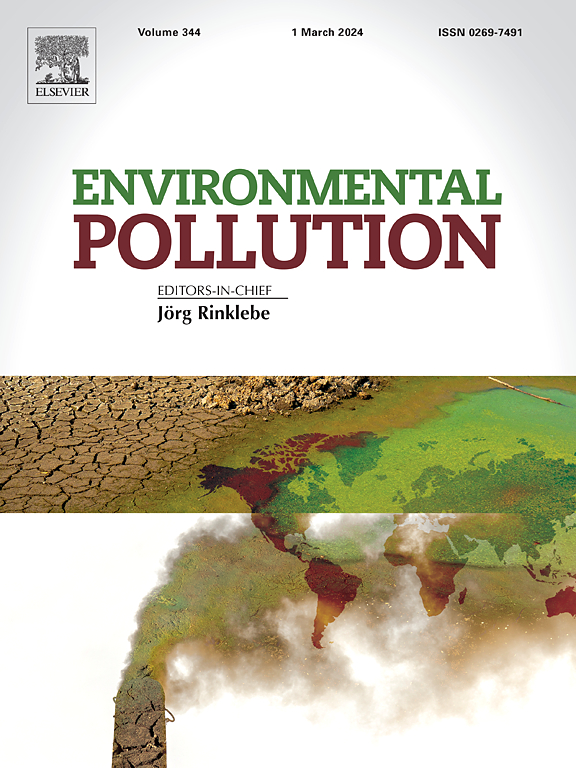Photoaged polystyrene nanoplastics induce perturbation of glucose metabolism in HepG2 cells via oxidative stress
IF 7.6
2区 环境科学与生态学
Q1 ENVIRONMENTAL SCIENCES
引用次数: 0
Abstract
Micro- & nano-plastics (MNPs) have been considered an emerging persistent pollutant in the environment. Most of the works focus on the potential toxicity of pristine, rather than photoaged, MNPs, let alone the underlying mechanisms of toxicity. To address this gap, we exposed human liver cancer cells (HepG2) to polystyrene nanoplastics (PS-NPs) with varying degrees of photodegradation, including pristine PS-NPs and photoaged PS-NPs irradiated with UV for 8 days (short-term) and 32 days (long-term).The surface characteristics of PS-NPs exhibited a significant alteration as characterized by SEM, FTIR, XPS, and Zetasizer. Exposure to PS-NPs affected cell viability, ion transport capacity and glucose metabolism, and also induced oxidative stress. Photoaged PS-NPs posed relatively higher impacts than pristine ones on HepG2 cells. Long-term photoaged PS-NPs induced the glucose metabolic disorders in a dose-dependent manner, while pristine and short-term photoaged PS-NPs induced the metabolic disorders only at high concentrations. The severe cellular metabolic toxicity of PS-NPs was attributed to the changes in physicochemical properties induced by UV irradiation, such as the production of oxygen-containing functional groups (hydroxyl, carboxyl, and carbonyl groups). Taken together, the long-term photoaged PS-NPs suppressed more than 10 % of cell vitality compared to the pristine ones, and disrupted the glucose metabolism in HepG2 cells, particularly gene expression associated with glucose homeostasis.

光老化聚苯乙烯纳米塑料通过氧化应激诱导HepG2细胞葡萄糖代谢的扰动
Micro&纳米塑料(MNPs)已被认为是一种新兴的环境持久性污染物。大多数工作都集中在原始MNPs的潜在毒性上,而不是光老化的MNPs,更不用说毒性的潜在机制了。为了解决这一空白,我们将人类肝癌细胞(HepG2)暴露于不同程度的光降解聚苯乙烯纳米塑料(PS-NPs)中,包括原始PS-NPs和经过紫外线照射8天(短期)和32天(长期)的光老化PS-NPs。通过SEM、FTIR、XPS和Zetasizer对PS-NPs的表面特征进行了表征。暴露于PS-NPs会影响细胞活力、离子转运能力和葡萄糖代谢,并诱导氧化应激。光老化的PS-NPs对HepG2细胞的影响高于未老化的PS-NPs。长期光老化的PS-NPs诱导糖代谢紊乱呈剂量依赖性,而原始和短期光老化的PS-NPs仅在高浓度下诱导糖代谢紊乱。PS-NPs的严重细胞代谢毒性归因于紫外线照射引起的物理化学性质的变化,如含氧官能团(羟基、羧基和羰基)的产生。综上所述,与原始细胞相比,长期光老化的PS-NPs抑制了超过10%的细胞活力,并破坏了HepG2细胞的葡萄糖代谢,特别是与葡萄糖稳态相关的基因表达。
本文章由计算机程序翻译,如有差异,请以英文原文为准。
求助全文
约1分钟内获得全文
求助全文
来源期刊

Environmental Pollution
环境科学-环境科学
CiteScore
16.00
自引率
6.70%
发文量
2082
审稿时长
2.9 months
期刊介绍:
Environmental Pollution is an international peer-reviewed journal that publishes high-quality research papers and review articles covering all aspects of environmental pollution and its impacts on ecosystems and human health.
Subject areas include, but are not limited to:
• Sources and occurrences of pollutants that are clearly defined and measured in environmental compartments, food and food-related items, and human bodies;
• Interlinks between contaminant exposure and biological, ecological, and human health effects, including those of climate change;
• Contaminants of emerging concerns (including but not limited to antibiotic resistant microorganisms or genes, microplastics/nanoplastics, electronic wastes, light, and noise) and/or their biological, ecological, or human health effects;
• Laboratory and field studies on the remediation/mitigation of environmental pollution via new techniques and with clear links to biological, ecological, or human health effects;
• Modeling of pollution processes, patterns, or trends that is of clear environmental and/or human health interest;
• New techniques that measure and examine environmental occurrences, transport, behavior, and effects of pollutants within the environment or the laboratory, provided that they can be clearly used to address problems within regional or global environmental compartments.
 求助内容:
求助内容: 应助结果提醒方式:
应助结果提醒方式:


